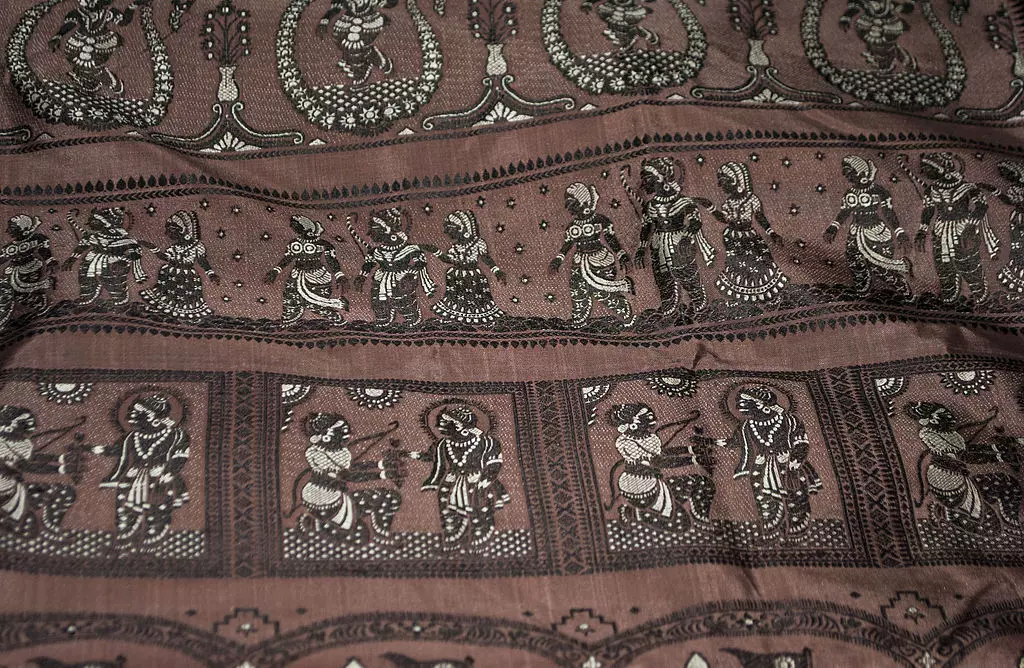Elegant sarees of Bishnupur
The journey of the handloom craft of weaving exquisite Baluchari sarees has been dotted with several ups and down — depending on the patrons, proponents and destroyers it encountered along the way

A thing of beauty is a joy forever, for it not only survives the vicissitudes of political fortunes, the changing course of rivers, and the onslaught of new technologies and market forces, but also resurrects itself in the face of every challenge.
The story of Baluchari is inextricably linked to Murshid Quli Khan, the legendary Nawab of Bengal who shifted his capital from Dhaka to Maqusdabad in 1704. The city was renamed Murshidabad in his honour in 1709. During its heydays, Murshidabad was the foremost city of Bengal, and all the major European powers — the Dutch, the Portuguese, the French and the British — had their factories and trading outposts in this flourishing trade centre. The Nawab of Bengal became a patron of its rich weaving tradition, as he played a key role in bringing craftsmen from Dhaka to the Baluchar village in Murshidabad. The hamlet, Baluchar (now Ziagunj), derived its name from ‘balu’ (sand) and ‘char’ (river bank). It was originally situated on the mighty Bhagirathi River, but as the river changed its course, the original settlement was submerged, leading the families to shift to Bishnupur in the neighbouring district of Bankura, which had been under the control of the Malla dynasty since 694 CE.
Records indicate that the Malla kings promoted Tussar silk, which was endemic to the region. Bishnupur served as the capital of the Malla dynasty, and various crafts flourished during their reign. The themes depicted on the silk sarees were derived from the Ramayana and Mahabharata. However, with changing patrons, the weavers adapted their skills to meet the new demands. Under the Nawabs of Bengal, with Murshid
Quli Khan being the most prominent, Baluchari weaving incorporated themes revolving around the lives of the nawabs, featuring women smoking hookahs, nawabs driving horse carriages, and even European officers of the East India Company.
However, as the East India Company consciously destroyed the native industry in favour of imported cloth, Baluchari weaving also nearly became extinct. It lost its patrons to machine-made georgettes and chiffons, which became the rage in the 19th and early 20th centuries.
The original Baluchari sarees in Murshidabad in the 18th and 19th centuries were woven on traditional Jala looms. The term ‘Jala’ refers to the master design from which multiple copies could be made repetitively for weaving the sarees. The process was highly elaborate, taking between 15-18 weeks to weave a saree, but it allowed for a wide range of intricate patterns. However, in this fast-paced age, where weavers also need to maximise their returns on time and effort, the traditional loom had to give way to the jacquard loom.
After Independence, there was a renewed interest in reviving traditional crafts, considering them as invaluable intangible heritage. Several organisations, including the Cottage Industries Emporium and promotional bodies of Union and state governments, took up the cause. Subho Thakur, a worthy descendant of Thakur Rabindranath, played a leading role in reviving the rich tradition of Baluchari craft. Recognising the expertise of Akshay Kumar Das, a master weaver from Bishnupur, Thakur invited him to his centre to learn the jacquard weaving technique. Das then returned to Bishnupur and worked diligently to weave Baluchari on their looms with the financial and moral support of Sri Hanuman Das Sarda from Silk Khadi Seva Mandal. This organisation was established on Gandhian principles of self-help, mutual support, and ethical production practices.
The production process for Baluchari sarees has been more or less standardised, and it can be broadly categorised based on the threads used in weaving the patterns. These categories include Resham, which is the simplest Baluchari, with Resham threads in a single colour used to weave the entire pattern. Then there is Meenakari, which involves the use of threads in two or more colours along with attractive Meenakari work that enhances the patterns. Finally, there is Swarnachari, or Baluchari in gold. These sarees are the most exquisite in their class, as they are interwoven with gold (Swarna) or silver-coloured threads (often with Meenakari work in another colour), making them heirloom-worthy possessions.
In order to preserve this exquisite craft and ensure national and global recognition for the artists engaged in it, the then Textiles Commissioner of West Bengal, Mr. Sh Hridyesh Mohan, applied for and successfully obtained the GI tag for practitioners of this craft in the geographical area of Bishnupur. Interestingly, Hridyesh also played a pivotal role in securing the GI tag for Darjeeling Tea when he served as the DM there. May his efforts inspire others to protect and promote such cultural treasures!
The writer superannuated as the Director of the LBSNAA after 36 years in the IAS, and is currently a historian and policy analyst.



